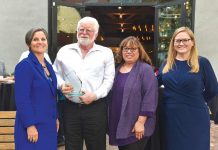
This installment of Barn Again! is about probably the most historically significant barn in the region—that red barn surrounded by a fence on the ranch side of Christmas Hill Park. While a search continues to find a deed or building permit, or other official document to settle the matter, many are quite sure this barn was built by Henry Miller.
Though barn-lovers are concerned about the loss of any of these grand reminders, there is a special fear about this barn because of its link to the “Cattle King” and because the City seems inclined to demolish it. The City Council has granted just a year for the community to raise money so the Miller Barn can be given a new lease on life. The Miller Red Barn Committee has been established to make sure the Barn is made safe for use without harming it’s historic value, and to find new uses. The Committee believes the barn will be a beautiful and important reflection of a farm economy that was once the mainstay, and remains an important part of, Gilroy’s economy; that it can be a center for local history and culture, and an icon of community identity much in the way Old City Hall is; and that it can be an engine for tourism, recreation and economic growth. Further, the Committee has found several regional models for transforming the barn and surroundings to accomplish these goals. You can be part of this effort to save an important piece of our agricultural history, contact Carol DeSantis at cd***********@***oo.com.
Miller the Man
Although Miller’s name is found on streets and parks in Gilroy, and locals usually have visited the Miller Ruins at Mount Madonna, you have to dig a little to learn more about this man who carved out a cattle empire. Here’s a start:
Henry Miller, together with his partner Charles Lux, is thought to have been the largest land owner and cattleman in the American West, perhaps the largest landowner in the entire nation! It’s been said that a cowboy could ride from Mexico all the way to Canada without leaving Miller & Lux lands. His fortune has been estimated at $25 million, and that’s measured in the dollar’s value when Miller was alive.
Born in Brachenheim, Germany in 1827 as Heinrich Alfred Kreiser, at age 15, Henry (Heinrich) began 5 years of training, under his father, as a butcher’s apprentice. About the time the apprenticeship was completed, his mother died and he left home to wander across Europe.
In 1850, at age 23, perhaps to avoid being drafted into the military, Heinrich bought a ticket to California from his friend, the “real” Henry Miller. That friend’s ticket was non-transferable, Heinrich decided to take his friend’s name so he could use the ticket as if it were his own. He sailed to New York and began work there as a butcher; soon he found his way to San Francisco—with just $6.00 to his name, and got a another job as a butcher. In 1857 he opened his own butcher shop, and a year later teamed with his competitor and fellow German immigrant Charles Lux, to buy a herd of cattle. Within yet another year he changed his name legally, and both he and Lux married sisters whose last name was Sheldon. Sadly, in 1860 his first wife, Nancy, died in childbirth..
Soon, Henry Miller and Charles Lux formalized their partnership as the Miller & Lux Company. Lux managed business matters while Miller supervised the ranches. About the same time, Henry Miller married Sarah, the niece of his first wife. The children of Sarah and Henry Miller were:
• Henry Miller Junior; born 1865, died in 1902.
• Nellie Miller; born 1867, died 1944; married C. Leroy Nickel and had two sons.
• Sarah Alice Miller; born 1869, died 1879 in a riding accident at age 12.
• Sarah Wilmarth Miller, also born 1869, died that same year
It’s said Miller found his way to Gilroy because he decided, as a butcher, the way to prosperity was to raise his own cattle. Reportedly, he tracked the source of cattle from a slaughter house to our area, where the trail led over Pacheco Pass to the Central Valley. Seeing the potential of this location, he bought land from the former ranchos of Las Animas, San Ysidro, Juristac, and Llano del Tequesquite. He also bought from the government, from “squatters” who had been waiting for U.S. Courts to straighten out ownership of the old land grants, as well as from descendants of the Spaniards and Mexicans who chose not to wait for the U.S. government to legitimize their land claims. One guiding principle was to have ranches a day’s ride apart so his cattle & men would have a place to rest at night.
Eventually, Miller purchased 20,000 acres in the South County. The 1,800 acres of Rancho Las Animas he bought from the heirs of Jose Maria Sanchez in 1859, became known as Bloomfield Ranch—well-situated, the Bloomfield Ranch had easy access for cattle drives coming over Pacheco Pass from Miller’s vast holdings in the San Joaquin Valley, and the building of a train line meant a direct route to the markets in San Francisco. The ranch was huge, with naturally wet meadows. There were also wetlands between San Felipe Lake and the Pajaro River, wetlands Miller set out to drain. Between 1873 and 1874, a canal was built that was almost 3 miles long, 14’ wide at bottom and 26’ at top, with a depth of 3’ to 7’. In all, about 7,000 acres were reclaimed and “The Bloomfield” became the headquarters for the Miller-Lux cattle empire.
In 1879, Miller purchased Mount Madonna from a lumberman to use for camping with family and friends, employees and businessmen. Loving the area, the Millers made it their summer home. Between 1890 and 1902, after 18 years of “camping” (though it became rather lavish camping), Miller built three “bungalows” at Mt. Madonna for his wife, son, and daughter. The remains of these are the Miller Ruins at Mount Madonna.
One part of Las Animas Rancho became known as the Glen and another as the Loma. Alongside Uvas Creek, it was an ideal pasture for resting his cattle after being driven over Pacheco Pass and before heading off for the slaughterhouse in South San Francisco. It was in the “Glen-Loma” Miller built a large hay barn to store hay for the dry summer season.
The following decades brought big changes. In 1887, Henry’s partner Charles Lux died; half of Lux’ share went to his widow and the other half to family in Germany. In 1897 the enterprise was reformed as The Miller & Lux Corporation, with shares going to Lux’ heirs to resolve issues over the estate. In 1905, Henry’s second wife Sarah died, and the next year the 1906 Earthquake and Fire destroyed Miller’s San Francisco mansion and slaughterhouse. In 1913 Henry Miller named his son-in-law C. Leroy Nickel as president of the corporation, and in
1916 Henry died at the Nickel’s Menlo Park home. After Miller’s death in 1916, his estate continued to run Glen-Loma as a fruit ranch.
In 1905, about a decade before Miller’s death, the Las Animas Winery was built in Gilroy. It started north of the city limits with seven acres purchased from Miller; Zinfandel grapes were the first planting. By the next year the Las Animas Winery leased 1,000 more acres from Henry Miller, including land near Bloomfield Ranch and a part of the Glen Ranch. In 1941 the Glen Ranch property was sold to the Filice family to raise wine grapes for their San Martin Winery. The Gilroy Dispatch reported, “Michael J. Filice is to revive the vineyard on the Glen Ranch, he recently purchased the last parcel of old Miller and Lux property.” So what was once a seasonal hay barn for Henry Miller’s cattle during the dry season became a hub for fruit and grape farming.
One reason I feel sure this barn in Christmas Hill Park is Henry Miller’s is the recollection of our family’s friend, Marie Estes. Now 92 and living in Washington, Marie’s father was Victor Bogiala [boh-jahl-ah], the foreman of Glen Ranch for San Martin Vineyards. Victor took that job in the early 1940s when Marie was fresh out of high school. She remembers the barn as being very old even at that time, certainly not built a few decades earlier.
I anxiously await the publication of a new book about Henry Miller by former Gilroyan, Patricia Baldwin Escammila. Patricia has been a major factor in developing the Gilroy Museum and may well be the foremost authority on Henry Miller. Here are some snippets from a letter she wrote to me:
“Miller was a good man….very generous….very strict with himself on work and expected nothing less of his employees….had an almost Puritan work ethic and abhorred uncleanliness and waste….a man of vision…an active mind that could work out a plan of action for everything he envisioned.”
There are several people in the area who know someone Miller employed. As an example, Bruna Goold’s grandfather, Pete Barboa, was Miller & Lux’s superintendent for the San Joaquin Valley operations. Jack Sturla was told by a classmate that Miller’s house burned in 1924 because of drunken cowboys who were barbecuing and for “kicks” lit a cat on fire; it darted under the house and there was no way to douse it before the place was engulfed—Jack remembers seeing the smoke from that fire. Jack’s grandmother sometimes cooked for Miller and one time when she was ill and Miller wanted steaks prepared for visitors, Jack’s mother-to-be—15 years old at the time, and very frightened—did the job. Jack said Miller was known for being strict, he didn’t throw money around and wasn’t noted for paying liberal wages. John and Betty Clark not only had an interesting story, but also a photo to back it up. They said Miller had a nephew, Heinrich (“Heinie”) Pfeiffer. Reportedly, about 1911 or 1912, Miller caught Heinie asleep in the back of a wagon, shook him and said, “Dein job ist sehr viel harte arbeit, die nacht ist zum schlafen!” (Your job is a lot of hard labor, the night is for sleeping). Somewhat humiliated by this experience, Heinie’s chance to get a little vengeance came at another time when Heinie found Miller sleeping in the cradle of a cluster of trees. Heinie stealthily took Miller’s photo but never told him about it—apparently it gave him great satisfaction to hold this little secret about his uncle, a very quiet revenge. When I showed her the photo, Patricia Escamilla had two things to say; one was that Miller could work all day on very little sleep, averaging four hours each night, “…and then took “power” naps of ten to twenty minutes in the afternoon if he felt his energy flagging, especially when touring ranch properties.” On the other hand, she wondered how Heinie, around the turn of the century, would have a personal camera.
One last tidbit about Henry Miller can be found at the Gilroy Museum. It tells about his encounter with the famous bandit, Tiburcio Vasquez. At the age of 16, Vasquez was accused of murder and spent more than twenty years as a fugitive. Henry Miller, when riding over Pacheco Pass, is said to have been robbed by Vasquez, but convinced the bandit to return a $20 gold piece so he could buy food and lodging. A couple of years later, Miller stopped for lunch in a saloon, recognized Tiburcio Vasquez, walked up to him and plunked $20 on the bar. Miller said he was repaying the money Vasquez “loaned” him.











